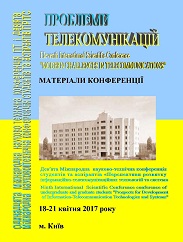МЕТОД ІДЕНТИФІКАЦІЇ СКЛАДНИХ НЕЛІНІЙНИХ ЗАЛЕЖНОСТЕЙ
Анотація
Method Identification of Complex Nonlinear Dependence
The research results are presented in the publication confirm the possibility of developing quite simple analytical model with the proposed method. The accuracy of the approximation meets the requirements of modern mathematical methods and object-oriented modeling. The developed model by this method can be used for analytical calculation of optimal modes of stochastic non-stationary objects, diagnosis of their condition, interpolation and extrapolation variable object
Посилання
Никитин Н.Н. Курс теоретической механики. – М.: Высшая школа, 1990. – 607 с.
Кириченко Ю.О. Математична модель напружено-деформованого стану рулонованого матеріалу // Вісник КНУТД. – 2004. – № 3. – 123 с.
Кострицький В.В., Кириченко Ю.О., Артеменко Л.Ф. Дослідження напружено-деформованого стану рулонованого матеріалу // Вісник КНУТД. – 2004. – № 5. – 163 с.
##submission.downloads##
Як цитувати
Скринник, О. М., & Сільвестров, А. М. (2017). МЕТОД ІДЕНТИФІКАЦІЇ СКЛАДНИХ НЕЛІНІЙНИХ ЗАЛЕЖНОСТЕЙ. Збірник матеріалів Міжнародної науково-технічної конференції «ПЕРСПЕКТИВИ ТЕЛЕКОМУНІКАЦІЙ». вилучено із https://conferenc-journal.its.kpi.ua/article/view/101381
Номер
Розділ
Сенсорні мережі та прикладні аспекти застосування телекомунікаційних технологій
Ліцензія
Авторське право (c) 2017 Олексій Миколайович Скринник, Антон Миколайович Сільвестров

Ця робота ліцензується відповідно до Creative Commons Attribution 4.0 International License.
Authors who submit to this conference agree to the following terms:a) Authors retain copyright over their work, while allowing the conference to place this unpublished work under a Creative Commons Attribution License, which allows others to freely access, use, and share the work, with an acknowledgement of the work's authorship and its initial presentation at this conference.
b) Authors are able to waive the terms of the CC license and enter into separate, additional contractual arrangements for the non-exclusive distribution and subsequent publication of this work (e.g., publish a revised version in a journal, post it to an institutional repository or publish it in a book), with an acknowledgement of its initial presentation at this conference.
c) In addition, authors are encouraged to post and share their work online (e.g., in institutional repositories or on their website) at any point before and after the conference.

